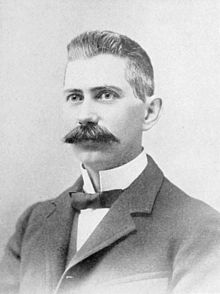
After a few years of experimenting with automobiles built at his home in Detroit, David Dunbar Buick – a former plumbing inventor and businessman – incorporated the Buick Motor Company on May 19, 1903. The first production vehicle, the Buick Model B, was offered to retail customers the following year.
David Dunbar Buick (September 17, 1854 – March 5, 1929) was a Scottish-born American Detroit-based inventor, best known for founding the Buick Motor Company. He headed this company from 1899 until 1906. Buick was born in Arbroath, Angus, Scotland and moved to Detroit at the age of two with his family. He left school in 1869 and worked for a company which made plumbing goods. When the company ran into trouble in 1882, he and a partner took it over. Buick began to show promise as an inventor, producing many innovations including a lawn sprinkler, and a method for permanently coating cast iron with vitreous enamel which allowed the production of white baths at lower cost, the company became quite successful. During the 1890s, Buick developed an interest in internal combustion engines and began experimenting with them. He was spending little time on the plumbing business, the partnership was dissolved and the company was sold.
Buick set up a new company, the Buick Auto-Vim and Power Company with the aim of marketing engines for agricultural use. Buick soon turned to the development of a complete car. The result was that he consumed his capital by early 1902 without having generated any significant return and only a single car. Later in 1902, he established the Buick Manufacturing Company with the objectives of marketing engines to other car companies and manufacturing its own brand cars. Problems ensued and at the end of 1902 Buick was out of money with only one car. David Buick had produced the revolutionary “Valve-in-Head” overhead valve engine. This method of engine produces a much more powerful engine than the side valve engine design used by all other manufacturers at the time. Overhead valve engines are used by most car manufacturers today, but now only GM and Chrysler produce the “push-rod” variant with any regularity. Since overhead cam engines are design variants of OHV engines, it is fair to classify virtually all modern engines as derivatives of Buick’s invention.
In 1903 Buick was forced to raise more money via a $5,000 loan from a friend and fellow car enthusiast, Benjamin Briscoe. In return for the finance, Briscoe gained a 97% interest in the Buick Motor Company. Briscoe sold the Buick Motor Car Company in 1904 to Flint Wagon Works and used the money to found the Maxwell-Briscoe Motor Company, makers of the Maxwell automobile.
David Buick later in life, after unsuccessful investments in California oil and Florida land, and an attempt to manufacture carburetors, Buick made a brief return to the automotive business in 1921, as president of the short-lived Lorraine Motors Corporation, The Lorraine was an automobile built in both Grand Rapids and Detroit, Michigan. The Lorraine was an assembled car that succeeded the Hackett. The vehicle was powered by a four-cylinder Herchell-Spillman engine and was available in both open and closed models. Only a few hundred models were sold. The Last known Lorraine Touring car is on display at the Grand Rapids Public Museum.
In 1923 with the design of the Dunbar, an automobile prototype, the self-designed car was never produced (see above photo). By 1928 he was destitute, in an interview, Buick admitted that he was almost completely broke, unable to even afford a telephone, he died from colon cancer on March 5, 1929 at the age of 74 in Detroit, Michigan. He was inducted into the Automotive Hall of Fame in 1974.

You must be logged in to post a comment.